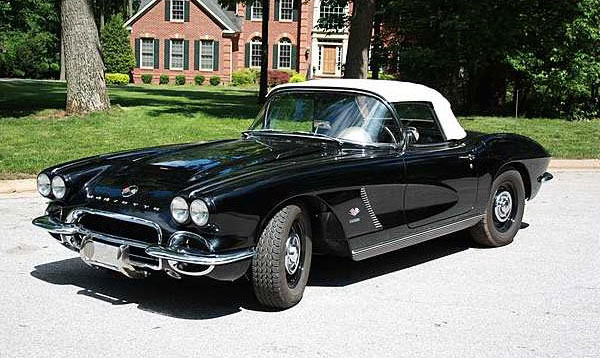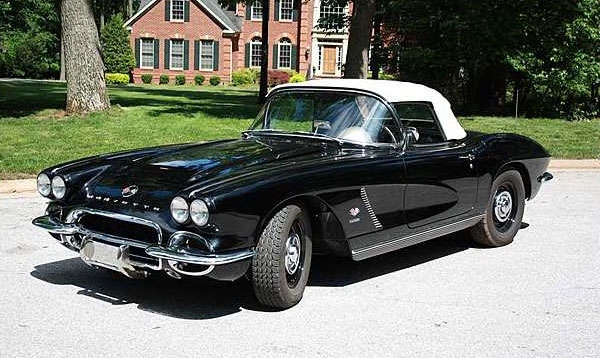
This immaculate, matching-numbers 1962 Corvette convertible was factory equipped with all the components necessary for all-out competition: the exceptionally rare RPO 687 “Big Brake” package that included special front and rear shocks, front brake deflector/air scoops, rear brake air scoops, metallic linings, finned drums with internal cooling fans and quick steering adapter—all developed and proven on the race track.
A Rochester fuel-injected, solid-lifter 327/360 V8 combines with the Code 685 Borg-Warner 4-speed and Positraction rear end. Finished in Tuxedo Black, with a Fawn Beige interior and white top, the car rolls on 15 x 5½-inch painted steel wheels and includes a Wonderbar signal-seeking radio.
{auto}1608{/auto}
SCM Analysis
Detailing
| Vehicle: | 1962 Corvette 327/360 Big Brake Fuelie |
| Years Produced: | 1962 |
| Number Produced: | 246 RPO 687 (out of 14,531 1962 Corvettes total) |
| Original List Price: | $5,461.65 |
| SCM Valuation: | $76,500–$132,500 (fuel-injected with hard top) |
| Tune Up Cost: | $150 |
| Distributor Caps: | N |
| Chassis Number Location: | VIN plate on the steering column |
| Engine Number Location: | Pad on front of block below right cylinder head |
| Club Info: | National Corvette Restorers Society 6291 Day Road Cincinnati, OH 45252 |
| Website: | www.ncrs.org |
| Alternatives: | 1962 Jaguar XKE 1961 Corvette 283/315 Fuelie 1963 Corvette 327/360 L84 Fuelie |
| Investment Grade: | N |
This car, Lot S84, sold for $90,100, including buyer’s premium, at Mecum’s Bloomington Gold Corvette Auction on June 25, 2011.
Prior to the Bloomington Gold auction this year, corvetteblogger.com ranked this Corvette as one of the four most desirable cars from the event they would like in their collection. I couldn’t agree more.
The thought of buying a factory race car for street use is usually fueled more by testosterone than sanity, but the Big Brake Corvettes, especially the 1962 versions, could be the rare exception.
The Big Brake option was introduced late in the 1957 model year, and the name actually refers to a series of Corvette options, all developed by Zora Arkus-Duntov and Chevrolet for the Corvette’s successful 12 Hours of Sebring campaign that year.
RPO 687 not only added the huge drum brakes and metallic linings needed to slow the heavy Corvette at racing speeds, but it also added quicker steering and the larger RPO 276 15 x 5½ inch wheels, RPO 675 Positraction axle, and the top-horsepower engine offered that model year.
With these options, you had a Corvette that was essentially a twin to what Dr. Dick Thompson, Jim Jeffords, and others were using to win consecutive SCCA Production class championships from 1957 to 1962.
A race car for the street
A total of 246 Big Brake Corvettes were sold in 1962, far more than could possibly be used for competition. That means that most of the cars were purchased for nothing more than the occasional Stoplight Grand Prix. But unlike the brutal L88 Corvette of the late 1960s, the Big Brake cars were actually well-suited to street use.
In a 1959 test of an RPO 687 Corvette, Road & Track magazine found the Cerametalix linings to be “not as effective when cold as when hot, and after the test was completed, the linings squeaked when the brakes were applied.” This is not a problem for racing, but it is a potential deal-breaker for a car bought for street use.
However, GM’s Delco Moraine division continued to refine the composition of these brakes, and by 1962, Car and Driver magazine could report “the grabby, unpredictable ceramic-metallic linings are now a thing of the past, having served their purpose as a stopgap until Moraine could design sufficient life and consistency into the sintered iron type.”
These brake improvements were necessary, as the new 327-ci V8 made the already-fast Corvette much faster, with an additional 45 horsepower for the fuel-injected version. Wrote Car Life magazine, “For sheer performance, there’s nothing like a Corvette. Especially the new FI model with more power—and torque—than ever!”
Quarter-mile times were about the same as the previous Fuelie, mostly due to horsepower overwhelming the contemporary tire technology, but Car Life found “…when we put away our stopwatches and relied on the seat of our pants, we did notice the difference. It was clearly evident on the highway, providing solid bursts for passing and climbing. Wheel spin isn’t a difficulty at road speeds and the bigger engine really has a chance to show its stuff. Here, the reason isn’t so much the greater horsepower as a sharp boost in torque.” They concluded: “When we reported on the 1961 Corvette in last September’s issue, we said, ‘We will readily admit that we would like very much to own a fuel-injected Corvette with all the options.’ Our experience with the 1962 model with its bigger bundle of torque made our desire stronger than ever.”
A Big Brake bargain
We’ve seen a 1962 Corvette with racing provenance break the $1,000,000 mark— the Gulf Oil Sebring winner featured in CM 5 (p. 24) sold for $1,485,000 in 2008. Another authentic racer, the Tony Settember/Jack Turner Le Mans car, sold for $489,500 in 2006.
Even 1962 Big Brake Corvettes without racing history have sold for as much as $176,000—that sale coming in January of this year. That Big Brake car, however, was restored by an NCRS judge and had NCRS Top Flight, Duntov awards and Bloomington Gold certification. A Roman Red 1962 Fuelie without the Big Brake option sold at this year’s Bloomington Gold auction for $106,000, and it too had earned Gold certification.
This Corvette has neither the provenance of racing nor the pedigree of NCRS or Gold certification, although the car looked properly restored. It was also sold just a few lots after a collection of 23 black Corvettes from 1954 to 1969 went across the block. After a steady stream of black Corvettes, maybe something as simple as color overload kept the bidding down on this Tuxedo Black car. Nevertheless, this is a highly desirable first-generation Corvette, which the buyer got on the cheap. Very well bought
